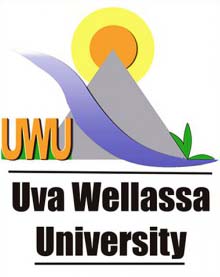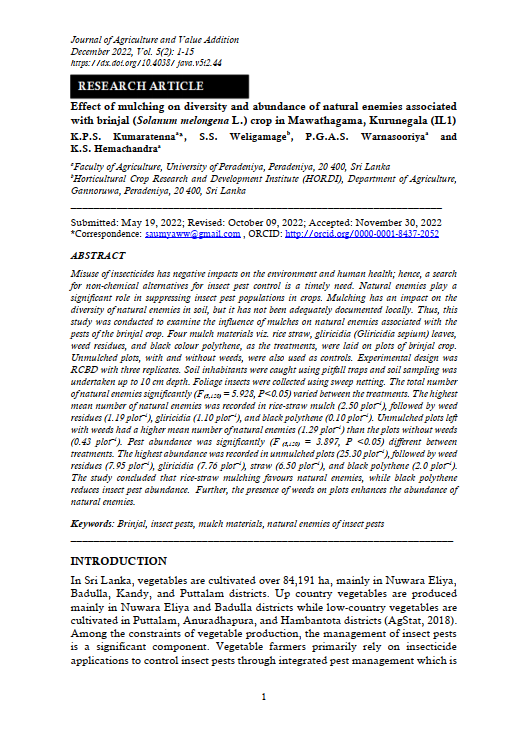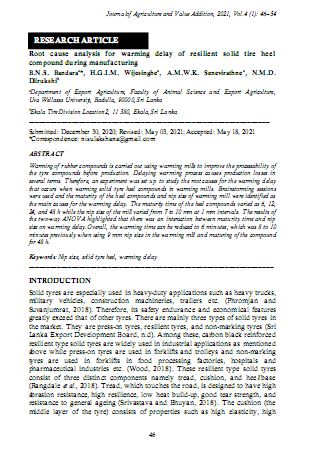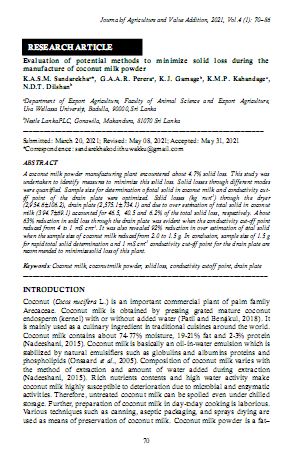
Volume 05 Issue 02
RESEARCH ARTICLES
01. Effect of mulching on diversity and abundance of natural enemies associated with brinjal (Solanum melongena L.) crop in Mawathagama, Kurunegala (IL1)
K.P.S. Kumaratennaa*, S.S. Weligamageb , P.G.A.S. Warnasooriya a and K.S. Hemachandra a
a Faculty of Agriculture, University of Peradeniya, Peradeniya, 20 400, Sri Lanka
b Horticultural Crop Research and Development Institute (HORDI), Department of Agriculture, Gannoruwa, Peradeniya, 20 400, Sri Lanka
INFORMATION
Journal Title: Journal of Agriculture and Value Addition
Volume : 5 Issue 02
Page : 1- 15
Submitted: May 19, 2022; Revised: October 09, 2022; Accepted: November 30
* Correspondence: saumyaww@gmail.com
ABSTRACT
Misuse of insecticides has negative impacts on the environment and human health; hence, a search for non-chemical alternatives for insect pest control is a timely need. Natural enemies play a significant role in suppressing insect pest populations in crops. Mulching has an impact on the diversity of natural enemies in soil, but it has not been adequately documented locally. Thus, this study was conducted to examine the influence of mulches on natural enemies associated with the pests of the brinjal crop. Four mulch materials viz. rice straw, gliricidia (Gliricidia sepium) leaves, weed residues, and black colour polythene, as the treatments, were laid on plots of brinjal crop. Unmulched plots, with and without weeds, were also used as controls. Experimental design was RCBD with three replicates. Soil inhabitants were caught using pitfall traps and soil sampling was undertaken up to 10 cm depth. Foliage insects were collected using sweep netting. The total number of natural enemies significantly (F(5,120) = 5.928, P<0.05) varied between the treatments. The highest mean number of natural enemies was recorded in rice-straw mulch (2.50 plot–1), followed by weed residues (1.19 plot–1), gliricidia (1.10 plot–1), and black polythene (0.10 plot–1). Unmulched plots left with weeds had a higher mean number of natural enemies (1.29 plot–1) than the plots without weeds (0.43 plot–1). Pest abundance was significantly (F (5,120) = 3.897, P <0.05) different between treatments. The highest abundance was recorded in unmulched plots (25.30 plot–1), followed by weed residues (7.95 plot–1), gliricidia (7.76 plot–1), straw (6.50 plot–1), and black polythene (2.0 plot–1). The study concluded that rice-straw mulching favours natural enemies, while black polythene reduces insect pest abundance. Further, the presence of weeds on plots enhances the abundance of natural enemies.
Keywords: Brinjal, insect pests, mulch materials, natural enemies of insect pests
02. Factors affecting the changes in meat and meat product consumption of high school students: A logistic regression analysis
J.M.D.R. Jayawardanaa, R.H.W. Nadeeshania, K.M.N.T.K. Bandarab, D.D. Jayasenaa*, C.M.B. Dematawewac
a Department of Animal Science, Faculty of Animal Science and Export Agriculture, Uva Wellassa University, Badulla 90 000, Sri Lanka
b Department of Technical Education, National Institute of Education, Maharagama 10 280, Sri Lanka
c Department of Animal Science, Faculty of Agriculture, University of Peradeniya, Peradeniya, 20 400, Sri Lanka
INFORMATION
Journal Title: Journal of Agriculture and Value Addition
Volume : 5 Issue 02
Page : 16- 29
Submitted: July 14, 2022; Revised: October 28, 2022; Accepted: November 15, 2022
* Correspondence: dinesh@uwu.ac.lk
ABSTRACT
Protein malnutrition remains a challenging and unresolved health problem among young children in Sri Lanka. This paper aimed to explore the impact of socio demographic attributes on meat and meat product consumption of young children and the factors that affect to change meat and meat products consumption. A total of 387 students aged 17-18 y from different subject streams in Kandy district, Sri Lanka were interviewed using a pre tested structured questionnaire. Binary logistic regression analysis was performed to investigate the socio-demographic factors. All factors possibly influencing meat and meat product consumption pattern were summarized into six factors (monetary, nutritional, health, quality, animal welfare, and advertising) using principal component analysis. Ordinal logistic regression analysis was performed for the linear combination of the above six principal components to investigate how those components affected the changes in meat and meat product consumption. The majority of students (82%) consumed both meat and processed meat products and chicken meat had the highest preference (75%) among the meat-eaters followed by beef (25.3%), pork (14.7%), and mutton (9.0%), respectively. Knowledge on meat quality standards, family income, and religion was the dominant socio-demographic factors that affected meat and meat product consumption (P<0.01). The majority of high school students (91%) were in the normal range of body mass index (18.5- 24.9). Monetary and advertising factors had a positive and negative impact (odds ratio=1.66 and 0.70) on the changes in meat and meat products consumption, respectively (P<0.01). Proper maintenance of meat quality and further research and development on nutritional aspects targeting healthier meat and meat products could lead to change in the perception of meat consumption of young school children in Sri Lanka.
Keywords: body mass index, chicken, high school, logistic regression, meat consumption
03. Effect of natural rubber tire waste charcoal (NRTWC) on soil chemical properties in tea growing soils
A.P.I. Mendisa*, B.C. Walpolab*, H.K.M.S. Kumarasinghea
a Department of Crop Science, Faculty of Agriculture, University of Ruhuna, Mapalana, Matara Kamburupitiya Road, 81 100, Sri Lanka
b Department of Soil Science, Faculty of Agriculture, University of Ruhuna Mapalana, Matara Kamburupitiya Road, 81 100, Sri Lanka
INFORMATION
Journal Title: Journal of Agriculture and Value Addition
Volume : 5 Issue 02
Page : 30- 44
August 31, 2022; Revised: December 17, 2022; Accepted: December 22, 2022
* Correspondence: bcwalpola@soil.ruh.ac.lk
ABSTRACT
Soil chemical properties are playing key roles in maximizing the production and quality of tea as well as sustainable management of tea-growing soils. Therefore, this study was carried out to assess the impacts of Natural Rubber Tire Waste Charcoal (NRTWC) application on major soil chemical properties in tea-growing soils. NRTWC was applied to a tea growing soil at different rates (0, 1, 1.6, 2.2 and 2.8% w/w) and soil chemical properties such as soil pH, organic matter content, NH4+- N, NO3--N, available P and exchangeable K were assessed at 10 and 20 weeks after application of NRTWC. NRTWC amended soils showed significantly (P≤0.05) higher pH values for the application rates of 2.2% (5.85) and 2.8% (5.86) than the control where it recorded the lowest pH value (5.3) at the 20 weeks after application. According to the results, it was observed that the application of NRTWC that contained a large amount of organic carbon (~50%) contributed to a significant (P ≤ 0.05) increase in the organic matter content of tea-growing soils. The highest organic matter (5.58%) was recorded with 2.8% NRTWC application followed by 2.2% application (4.66%) 20 weeks after application. Furthermore, slow decomposition of the NRTWC increases total N (NH4+-N and NO3--N), available P and exchangeable K content in the soils. Significantly (P≤0.05) higher NH4+-N contents were observed for all the treatments at 20 weeks after the application of NRTWC compared to the control. However, amended soils showed significantly (P≤0.05) higher NO3--N contents for the application rates of 2.2 and 2.8% (3.9 and 6.9 mg kg-1soil, respectively) compared to the control (1.8 mg kg-1soil) at 20 weeks after application. The 2.8% application rate recorded the highest exchangeable K content at 10 weeks (143 mg kg-1soil) and 20 weeks (195 mg kg-1soil) after treatment application. As revealed by the results, NRTWC can be considered as a good source of soil amendment which could enhance soil chemical properties in degraded tea soils.
Keywords: Charcoal, decomposition, organic amendments, natural rubber tire.
04. Appropriate conventional methods for estimating missing precipitation values in Sri Lanka
P.W. Jeewanthia*, W. Wijesuriyab, L.A.T.S. Liyanarachchic, L.H.P. Gunatathned
a Department of Export Agriculture, Uva Wellassa University, Badulla, 90 000, Sri Lanka
b Biometry Section, Rubber Research Institute of Sri Lanka, Dartonfield, Agalawatta,12 200, Sri Lanka
c Department of Soils and Plant Nutrition, Rubber Research Institute of Sri Lanka, Dartonfield, Agalawtta,12 200, Sri Lanka
d Department of Agricultural Economics and Business Management, University of Peradeniya, 20 400, Sri Lanka
INFORMATION
Journal Title: Journal of Agriculture and Value Addition
Volume : 5 Issue 02
Page : 45- 53
Submitted: September 05, 2022; Revised: December 24, 2022; Accepted: December 26, 2022
* Correspondence: wasanap@uwu.ac.lk
ABSTRACT
This study focused on finding the most appropriate conventional method for estimating missing precipitations values in different climate zones in Sri Lanka. The main location and surrounding locations were selected from each zone considering their data availability. Monthly precipitation data for each selected locations were collected from 1980 to 2020. Three temporal methods; Holt Winter’s Exponential Smoothing, Seasonal Auto Regressive Integrated Moving Average and, Multiple Aggregation Prediction Algorithm and four spatial methods; namely, Arithmetic Mean Method (AMM), Normal Ratio Method (NR), Inverse Distance Weightage Method (IDW) and Aerial Precipitation Ratio (APR) method were used for estimating missing values. Root Mean Square Error, Mean Absolute Error, and Mean Absolute Percentage Error values were used for selecting the most appropriate method for estimating missing values for each location. It was difficult to name one method as the most appropriate method for all climate zones. Spatial methods have performed better than temporal methods in all seven climate zones. The missing values in the Low Country Wet Zone and Up Country Wet Zone could be estimated using AMM and NRM methods. APR method is the most suitable for estimating missing values in the Mid Country Wet Zone and Low Country Intermediate Zone. IDM method performed well in Mid Country Intermediate Zone, Up Country Intermediate Zones and Low Country Dry Zone. However, further improvement of both temporal and spatial methods for estimating missing values is necessary as none of these methods are capable of giving estimates with high accuracy.
Keywords: Estimate, missing values, precipitation, spatial methods, temporal methods
05. Effects of curing time, abscisic acid content and storage methods on the organoleptic properties of boiled potato (Solamun tuberosum) chips
M. Ahmeda*, D.T. Gungula b, V.T.Tame b
a Department of Crop Science, Adamawa State University, PMB 25, Mubi-Nigeria
bDepartment of Crop Production and Horticulture, Modibbo Adama University, PMB 2076, Yola Nigeria
INFORMATION
Journal Title: Journal of Agriculture and Value Addition
Volume : 5 Issue 02
Page : 54- 81
Submitted: October 25, 2022; Revised: November 12, 2022; Accepted: December 15, 2022
* Correspondence: ahmed361@adsu.edu.ng
ABSTRACT
The study assesses the role of curing, exogenous Abscisic Acids (ABA) and storage methods on the organoleptic properties of ware potatoes after long term storage. The study consisted of three factors namely; curing, storage methods and ABA rates which were allocated to main plot, subplot and sub-sub-plot respectively in a Split-Split-Plot Design (SSPD). Treatments were replicated three times, consisting of 20 tubers, and data on organoleptic properties were generated at the end of the storage period. The data were subjected to Analysis of Variance (ANOVA) using SPSS. Means that showed significant difference was separated using Duncan’s Multiple Range Test (DMRT) at 0.5% level of probability. The findings revealed that curing, storage methods and exogenous ABA rates had a very high significant (P≤0.001) impact and interaction of these factors on acceptability, aroma, colour, taste and texture of potatoes after long-term storage. Thus, curing period, storage condition and ABA can be employed in the extension of the shelf-life of potato tubers under ambient conditions with little loss of organoleptic properties of the tubers after storage. Further studies are required for confirming results.
Keywords : Curing, Abscisic acid, organoleptic properties, Storage methods
06. Physicochemical characteristics of Palmyrah bottled toddy and their effect on storage
S. Mahilrajan a* and S. Thurisingam a
a Palmyrah Research Institute, Kandy Road, Kaithady,40 000, Jaffna, Sri Lanka
INFORMATION
Journal Title: Journal of Agriculture and Value Addition
Volume : 5 Issue 02
Page : 82- 92
Submitted: October 31, 2022; Revised: December 16, 2022; Accepted: December 26, 2022
* Correspondence: subajini@gmail.com
ABSTRACT
In the northern and eastern parts of Sri Lanka, the cloudy whitish toddy is obtained by tapping young or matured inflorescence of both female and male palmyrah palm (Borassus flabellifer), preserved them by using pasteurization techniques and then sold. In the present study, the effect of heat and storage period on the physicochemical characteristics as well as nutritional and mineral content of fresh and preserved toddy were determined. Preserved toddy showed a significantly (P<0.05) higher alcohol (%) 3.80(±0.07), acidity (%) 0.60(±0.07), turbidity (NTU) 2,694.50 (±0.07), relative density 1.01 (±0.07) and total solid (g/L) 58.22 (±0.07) while the total soluble solids (obrix) 5.93(±0.07) and pH 3.43 (±0.07) showed significantly lesser values compared to the fresh toddy. However, there was no significant (P>0.05) difference in protein 1.42(±0.01) g, fat 0.02(±0.00) g, iron 11.9(±0.3) mg, phosphorus 0.64(±0.04) mg, calcium 13.5(±0.5) mg and magnesium 5.3(±0.5) mg/100 mL. During pasteurization, total sugar and ascorbic acid content were significantly (P<0.05) decreased from 3.04(±0.06) to 2.80(±0.01) g/100 mL and 3.0(±0.01) to 2.1(±0.01), respectively. When pasteurized toddy was stored at room temperature, there were no significant differences between the storage period of twelve months in alcohol 2.9(±0.60), acidity 0.5(±0.10), TSS 7.9(±0.6), pH 3.6(±0.01) and TS 69.4(±9.3). In conclusion, the physicochemical characteristics of palmyrah bottled toddy were not influenced by the pasteurization process and period of storage of twelve months.
Keywords : Palmyrah, toddy, pasteurization, alcohol percentage and storage






